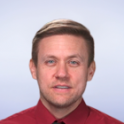Playlist
Show Playlist
Hide Playlist
Cranial Nerves: Introduction
-
Slides Anatomy Cranial Nerves Introduction.pdf
-
Reference List Anatomy.pdf
-
Download Lecture Overview
00:01 Let's take an overview of the cranial nerves. 00:05 The cranial nerves will be discussed in greater detail as they come up throughout the head anatomy portion, but I think it's worth looking at all of them together to give you an idea of what they're doing overall. 00:18 To start, let's look at how they're numbered. 00:22 They're generally numbered from anterior to posterior, as they come off of the brain. 00:29 For example, cranial nerve one is actually very far anterior, and it's actually made up of many small nerves. 00:37 It's actually a bunch of tiny nerves that sit in the olfactory mucosa of the upper nasal cavity. 00:44 And they're going to carry out smell. 00:48 A little bit further back, we have the optic nerves, and they're carrying vision from the retina. 00:56 Cranial nerve III is the oculomotor nerve, so named because it innervates muscles that move the eyeball. 01:04 Cranial nerve IV called the trochlear nerve has to do with a tiny little pulley thing called the trochlea that's related to another one of the extra ocular muscles. 01:14 Similarly abducens, innervates a muscle that abducts the eye hence its name. 01:23 Cranial nerve V, the trigeminal nerve is so named because it has three separate branches ophthalmic maxillary and mandibular. 01:33 And it carries out both sensory and motor functions. 01:37 Cranial nerve VII innervates the muscles of facial expression and that's called the facial nerve. 01:45 Cranial nerve VIII, vestibulocochlear has both vestibular and cochlear functions meaning they're related to equilibrium and hearing. 01:55 Cranial nerve nine glossopharyngeal has areas of the tongue and pharynx that interacts with, it has both motor and sensory innervation as well hence its name the glossopharyngeal nerve. 02:10 The vagus nerve does a little bit of everything, sensation, parasympathetic, it has motor innervation and it goes all the way down to the colon. 02:22 So it's called vagus because it wanders like a Vega bond. 02:28 Cranial nerve XI, the accessory nerve is a little bit of a misnomer in the sense that it actually originates in the spinal cord, but it does enter the cranial cavity so that actually ends up exiting. 02:39 So that is really what makes it a cranial nerve because it exits the cranium, but it innervates two muscles that move the head, neck and shoulders. 02:51 Finally cranial nerve XII, hypoglossal, provides motor innervation to the tongue or glossus hence its name. 03:01 The cranial nerves can kind of be summarized here in terms of what they do most generally. 03:07 So we have somatic versus visceral, meaning sort of the body and things you can control versus organs. 03:15 That's what's meant by visceral. 03:17 We also have special senses that are carried out by the cranial nerves. 03:22 Those are things like vision or smell. 03:25 And as you can see, we have a nice summary here of which things are done by which nerves.
About the Lecture
The lecture Cranial Nerves: Introduction by Darren Salmi, MD, MS is from the course Neurovasculature of the Head.
Included Quiz Questions
Which cranial nerve is responsible for vision?
- II
- VII
- I
- X
- XII
Which nerve controls the muscles of mastication?
- V
- VI
- II
- XI
- XII
Which nerve controls the muscles of the neck?
- XI
- X
- IX
- VII
- VI
Customer reviews
5,0 of 5 stars
| 5 Stars |
|
5 |
| 4 Stars |
|
0 |
| 3 Stars |
|
0 |
| 2 Stars |
|
0 |
| 1 Star |
|
0 |




